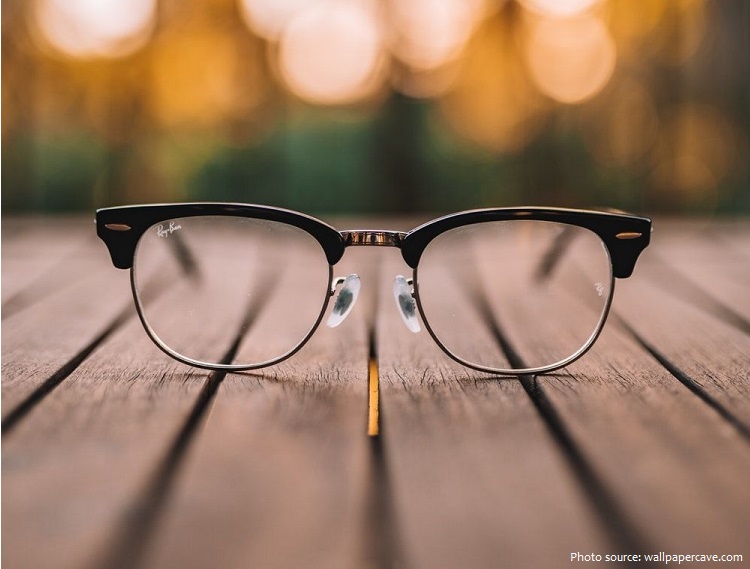
Glasses, also called eyeglasses or spectacles, are frames-bearing lenses worn in front of the eyes normally for vision correction or eye protection or for protection from UV rays.
The inventor of the first spectacle lenses is unknown.
Scattered evidence exists for use of visual aid devices in Greek and Roman times, most prominently the use of an emerald by emperor Nero as mentioned by Pliny the Elder.
Roman tragedian Seneca (4 BC -65AD) is said to have used a glass globe of water as a magnifier to read ”all the books of Rome”. It’s been reported that monks in the middle ages used glass spheres as magnifying glasses to read.

In 1268 Roger Bacon made the earliest recorded comment on the use of lenses for optical purposes, but magnifying lenses inserted in frames were used for reading both in Europe and China at this time, and it is a matter of controversy whether the West learned from the East or vice versa.
The 13th century Venetians glass blowers are known to have produced reading stones made of solid glass that was put into hand-held, single lens-type frames made of horn or wood. These reading stones were similar to hand-held magnifying lenses of today.
Most historians believe that the first form of eyeglasses was produced in Italy by monks or craftsmen in Pisa (or perhaps Venice) around 1285-1289. These magnifying lenses for reading were shaped like two small magnifying glasses and set into bone, metal, or leather mountings that could be balanced on the bridge of nose.

In Europe eyeglasses first appeared in Italy, their introduction being attributed to Alessandro di Spina of Florence. The first portrait to show eyeglasses is that of Hugh of Provence by Tommaso da Modena, painted in 1352.
In 1480 Domenico Ghirlandaio painted St. Jerome at a desk from which dangled eyeglasses – as a result, St. Jerome became the patron saint of the spectacle-makers’ guild. The earliest glasses had convex lenses to aid farsightedness. A concave lens for myopia, or nearsightedness, is first evident in the portrait of Pope Leo X painted by Raphael in 1517.
Marco Polo is mistakenly claimed to have encountered eyeglasses during his travels in China in the 13th century. However, no such evidence appears in his accounts. Indeed, the earliest mentions of eyeglasses in China occur in the 15th century and those Chinese sources state that eyeglasses were imported.

Scholar, inventor, and politician Benjamin Franklin had a personal interest in improved eyeglasses design since he needed them to read and write. It was Franklin who invented the first pair of “bifocals,” in 1784 which allowed the wearer to see far distances and have the ability to read or look at things at a close distance without having to remove their glasses. In the beginning, Franklin did this by cutting two different lenses in half and then replacing them in a frame.
Cemented bifocals were invented in 1884, and the fused and one-piece types followed in 1908 and 1910, respectively. Trifocals and new designs in bifocals were later introduced, including the Franklin bifocal revived in one-piece form.
Eyeglasses continued to be a luxury for the rich all the way into and beyond the 19th century. Fortunately, the industrial revolution made large-scale production possible. While still pricey, most middle-class adults finally could save up and purchase a pair. As you can imagine, eyeglasses were considered “precious” to the owners since their price made them almost impossible to replace on the spot for all but the upper classes.

In the 1930s, “spectacles” were described as “medical appliances”. Wearing spectacles was sometimes considered socially humiliating. In the 1970s, fashionable glasses started to become available through manufacturers, and governments also recognized the demand for stylized eyewear.
In the early 20th century, Moritz von Rohr at Zeiss (with the assistance of H. Boegehold and A. Sonnefeld) developed the Zeiss Punktal spherical point-focus lenses that dominated the eyeglass lens field for many years.
The Chopard De Rigo Vision Sunglasses are the most expensive glares in the world. They are an ultra-haute and extremely stylish pair! They come with a whopping $408,000 price tag! The C monogram of the creators is eddied on the crest!
The longest line of spectacles consisted of 16,530 pairs of spectacles, measured 2,011 m (6,597 ft 9 in) and was created by Sabae Megane Guinness 2011 committee (Japan) at Nishiyama Park, Sabae, Fukui, Japan, on 5 May 2011. Sabae produces 90% of glasses in Japan. The record attempt is to promote the city as the country’s top glasses production region.
